Research on the Impact of COVID-19 on Micromobility Using Statistical Methods
Abstract
:1. Introduction
2. Literature Review
3. Materials and Methods
3.1. Independence Test
3.2. Correspondence Analysis
4. Results
4.1. Independence Test for Alternative Modes of Public Transport
4.2. Correspondence Analysis for Alternative Modes of Public Transport
5. Discussion
6. Conclusions
Author Contributions
Funding
Institutional Review Board Statement
Informed Consent Statement
Data Availability Statement
Conflicts of Interest
References
- Wang, M.; Zhou, X. Bike-sharing systems and congestion: Evidence from US cities. J. Transp. Geogr. 2017, 65, 147–154. [Google Scholar] [CrossRef]
- Zhang, Y.; Mi, Z. Environmental benefits of bike sharing: A big data-based analysis. Appl. Energy 2018, 220, 296–301. [Google Scholar] [CrossRef]
- Li, A.; Zhao, P.; He, H.; Axhausen, K.W. Understanding the variations of micro-mobility behavior before and during COVID-19 pandemic period. Arb. Verk.-Und Raumplan. 2020, 1547, 1–20. [Google Scholar] [CrossRef]
- Hosseinzadeh, A.; Kluger, R. Analyzing the impact of COVID-19 pandemic on micromobility transportation. In Proceedings of the International Conference on Transportation and Development, Austin, TX, USA, 8–10 June 2021. [Google Scholar] [CrossRef]
- Chen, M.; Wang, D.; Sun, Y.; Waygood, E.O.D.; Yang, W. A comparison of users’ characteristics between station-based bikesharing system and free-floating bikesharing system: Case study in Hangzhou, China. Transportation 2020, 47, 689–704. [Google Scholar] [CrossRef]
- Yang, X.; Jiang, H. Influence of electronic-docking stations on China’s dockless bikesharing programs: Evidence from Beijing. Sustainability 2020, 12, 3588. [Google Scholar] [CrossRef]
- Yan, X.; Gao, L.; Chen, J.; Ye, X. Usage and temporal patterns of public bicycle systems: Comparison among points of interest. Information 2021, 12, 470. [Google Scholar] [CrossRef]
- Link, C. Who, how and why? First insights into the new stationless bikesharing schemes in Vienna. Transp. Res. Procedia 2019, 41, 162–164. [Google Scholar] [CrossRef]
- Baek, K.; Lee, H.; Chung, J.H.; Kim, J. Electric scooter sharing: How do people value it as a last-mile transportation mode? Transp. Res. Part D Transp. Environ. 2021, 90, 102642. [Google Scholar] [CrossRef]
- Elhenawy, M.; Komol, M.R.; Masoud, M.; Liu, S.Q.; Ashqar, H.I.; Almannaa, M.H.; Rakha, H.A.; Rakotonirainy, A. A novel crowdsourcing model for micro-mobility ride-sharing systems. Sensors 2021, 21, 4636. [Google Scholar] [CrossRef]
- Zafri, N.M.; Khan, A.; Jamal, S.; Alam, B.M. Risk perceptions of COVID-19 transmission in different travel modes. Transp. Res. Interdiscip. Perspect. 2022, 13, 100548. [Google Scholar] [CrossRef]
- Gaglione, F. Strategies and guidelines for urban sustainability: The explosion of micromobility from COVID-19. Tema 2020, 13, 465–470. [Google Scholar] [CrossRef]
- Warren, M.S.; Skillman, S.W. Mobility changes in response to COVID-19. arXiv 2020, arXiv:2003.14228. [Google Scholar] [CrossRef]
- Kissler, S.; Tedijanto, C.; Lipsitch, M.; Grad, Y.H. Social distancing strategies for curbing the COVID-19 epidemic. MedRxiv 2020. [Google Scholar] [CrossRef]
- Hu, T.; Wang, S.; She, B.; Zhang, M.; Huang, X.; Cui, Y.; Khuri, J.; Hu, Y.; Fu, X.; Wang, X.; et al. Human mobility data in the COVID-19 pandemic: Characteristics, applications, and challenges. Int. J. Digit. Earth 2021, 14, 1126–1147. [Google Scholar] [CrossRef]
- Pan, Y.; Darzi, A.; Kabiri, A.; Zhao, G.; Luo, W.; Xiong, C.; Zhang, L. Quantifying human mobility behavior changes in response to non-pharmaceutical interventions during the COVID-19 outbreak in the united states. arXiv 2020, arXiv:2005.01224. [Google Scholar] [CrossRef]
- Changruenngam, S.; Bicout, D.J.; Modchang, C. How the individual human mobility spatio-temporally shapes the disease transmission dynamics. Sci. Rep. 2020, 10, 11325. [Google Scholar] [CrossRef]
- Meloni, S.; Perra, N.; Arenas, A.; Gómez, S.; Moreno, Y.; Vespignani, A. Modeling human mobility responses to the large-scale spreading of infectious diseases. Sci. Rep. 2011, 1, 62. [Google Scholar] [CrossRef]
- Yue, H.; Hu, T. Geographical detector-based spatial modeling of the COVID-19 mortality rate in the continental united states. Int. J. Environ. Res. Public Health 2021, 18, 6832. [Google Scholar] [CrossRef]
- Martin, S.; Bergmann, J. (Im)mobility in the age of COVID-19. Int. Migr. Rev. 2021, 55, 660–687. [Google Scholar] [CrossRef]
- Harantová, V.; Hájnik, A.; Kalašová, A.; Figlus, T. The Effect of the COVID-19 Pandemic on Traffic Flow Characteristics, Emissions Production and Fuel Consumption at a Selected Intersection in Slovakia. Energies 2022, 15, 2020. [Google Scholar] [CrossRef]
- Zhang, L.; Darzi, A.; Ghader, S.; Pack, M.L.; Xiong, C.; Yang, M.; Sun, Q.; Kabiri, A.; Hu, S. Interactive COVID-19 mobility impact and social distancing analysis platform. Transp. Res. Rec. 2021, 03611981211043813. [Google Scholar] [CrossRef]
- Luis-Martínez, R.; Di Marco, R.; Weis, L.; Cianci, V.; Pistonesi, F.; Baba, A.; Carecchio, M.; Biundo, R.; Tedesco, C.; Masiero, S.; et al. Impact of social and mobility restrictions in Parkinson’s disease during COVID-19 lockdown. BMC Neurol. 2021, 21, 332. [Google Scholar] [CrossRef]
- Koenig, A.; Dressler, A. A mixed-methods analysis of mobility behavior changes in the COVID-19 era in a rural case study. Eur. Transp. Res. Rev. 2021, 13, 15. [Google Scholar] [CrossRef]
- Wergin, J.; Buehler, R. Where do bikeshare bikes actually go?: Analysis of capital bikeshare trips with GPS data. Transp. Res. Rec. 2017, 2662, 12–21. [Google Scholar] [CrossRef]
- Mishra, S.; Singh, N.; Bhattacharya, D. Application-Based COVID-19 Micro-Mobility Solution for Safe and Smart Navigation in Pandemics. ISPRS Int. J. Geo-Inf. 2021, 10, 571. [Google Scholar] [CrossRef]
- Xiao, Y.; Huang, L.; Xie, J.; So, H.C. Approximate asymptotic distribution of locally most powerful invariant test for independence: Complex case. IEEE Trans. Inf. Theory 2018, 64, 1784–1799. [Google Scholar] [CrossRef]
- McHugh, M.L. The chi-square test of independence. Biochem. Med. 2013, 23, 143–149. [Google Scholar] [CrossRef]
- Sei, Y.; Ohsuga, A. Privacy-preserving chi-squared test of independence for small samples. BioData Min. 2021, 14, 6. [Google Scholar] [CrossRef]
- Ali, F.; Dissanayake, D.; Bell, M.; Farrow, M. Investigating car users’ attitudes to climate change using multiple correspondence analysis. J. Transp. Geogr. 2018, 72, 237–247. [Google Scholar] [CrossRef]
- Doey, L.; Kurta, J. Correspondence analysis applied to psychological research. Tutor. Quant. Methods Psychol. 2011, 7, 5–14. [Google Scholar] [CrossRef]
- Hanada, M. Correspondence analysis of color–emotion associations. Color Res. Appl. 2018, 43, 224–237. [Google Scholar] [CrossRef]
- Oeschger, G.; Carroll, P.; Caulfield, B. Micromobility and public transport integration: The current state of knowledge. Transp. Res. Part D Transp. Environ. 2020, 89, 102628. [Google Scholar] [CrossRef]
- Ignaccolo, M.; Inturri, G.; Cocuzza, E.; Giuffrida, N.; Le Pira, M.; Torrisi, V. Developing micromobility in urban areas: Network planning criteria for e-scooters and electric micromobility devices. Transp. Res. Procedia 2022, 60, 448–455. [Google Scholar] [CrossRef]
- Lo, D.; Mintrom, C.; Robinson, K.; Thomas, R. Shared micromobility: The influence of regulation on travel mode choice. N. Z. Geogr. 2020, 76, 135–146. [Google Scholar] [CrossRef]
- Nikitas, A.; Tsigdinos, S.; Karolemeas, C.; Kourmpa, E.; Bakogiannis, E. Cycling in the era of COVID-19: Lessons learnt and best practice policy recommendations for a more bike-centric future. Sustainability 2021, 13, 4620. [Google Scholar] [CrossRef]
- Schaefer, K.J.; Tuitjer, L.; Levin-Keitel, M. Transport disrupted–substituting public transport by bike or car under COVID-19. Transp. Res. Part A Policy Pract. 2021, 153, 202–217. [Google Scholar] [CrossRef]
- Adaros-Boye, M.; Duclos-Bastías, D.; Giakoni-Ramírez, F.; Espinoza-Oteiza, L.; Cid-Robles, C.; Gálvez-Carvajal, J.; Matus-Castillo, C. Promoting sustainable mobility: Impact of an urban biking programme on university students. Sustainability 2021, 13, 12546. [Google Scholar] [CrossRef]
- Dias, G.; Arsenio, E.; Ribeiro, P. The role of shared E-scooter systems in urban sustainability and resilience during the COVID-19 mobility restrictions. Sustainability 2021, 13, 7084. [Google Scholar] [CrossRef]
- Kramarova, Z.; Kankovsky, A. Mobility in public spaces of small towns in the Czech Republic. IOP Conference Series. Mater. Sci. Eng. 2020, 960, 42090. [Google Scholar] [CrossRef]
- Fridrisek, P.; Janos, V. COVID-19 and suburban public transport in the conditions of the Czech Republic. Transp. Res. Interdiscip. Perspect. 2022, 13, 100523. [Google Scholar] [CrossRef]
- Bieliński, T.; Ważna, A. Electric scooter sharing and bike sharing user behaviour and characteristics. Sustainability 2020, 12, 9640. [Google Scholar] [CrossRef]
- Bieliński, T.; Dopierała, Ł.; Tarkowski, M.; Ważna, A. Lessons from implementing a metropolitan electric bike sharing system. Energies 2020, 13, 6240. [Google Scholar] [CrossRef]
- Bozzi, A.D.; Aguilera, A. Shared E-scooters: A review of uses, health and environmental impacts, and policy implications of a new micro-mobility service. Sustainability 2021, 13, 8676. [Google Scholar] [CrossRef]
- Cannata, G.; Nigro, M.; Ljoka, C.; Murè, M.; Coluccia, G.; Giordani, L.; Crisalli, U.; Foti, C. Mobility scooters in italy: The reason of a “missed revolution”. A potential resource for individual mobility in the COVID-19 era needs legislation. Tema 2021, 14, 343–366. [Google Scholar] [CrossRef]
- Ayfantopoulou, G.; Stamelou, A. Assessing the impact of COVID-19 on bike-sharing usage: The case of Thessaloniki, Greece. Sustainability 2020, 12, 8215. [Google Scholar] [CrossRef]
- Mejía-Dorantes, L.; Montero, L.; Barceló, J. Mobility Trends before and after the Pandemic Outbreak: Analyzing the Metropolitan Area of Barcelona through the Lens of Equality and Sustainability. Sustainability 2021, 13, 7908. [Google Scholar] [CrossRef]
- Heydari, S.; Konstantinoudis, G.; Behsoodi, A.W. Effect of the COVID-19 pandemic on bike-sharing demand and hire time: Evidence from Santander cycles in London. PLoS ONE 2021, 16, e0260969. [Google Scholar] [CrossRef]
- Vickerman, R. Will COVID-19 put the public back in public transport? A UK perspective. Transp. Policy 2019, 103, 95–102. [Google Scholar] [CrossRef]
- Christoforou, Z.; Gioldasis, C.; de Bortoli, A.; Seidowsky, R. Who is using e-scooters and how? Evidence from Paris. Transp. Res. Part D Transp. Environ. 2021, 92, 102708. [Google Scholar] [CrossRef]
- Lee, M.; Zhao, J.; Sun, Q.; Pan, Y.; Zhou, W.; Xiong, C.; Zhang, L. Human mobility trends during the early stage of the COVID-19 pandemic in the United States. PLoS ONE 2020, 15, e0241468. [Google Scholar] [CrossRef]
- Yan, X.; Zhu, Z. Quantifying the impact of COVID-19 on e-bike safety in china via multi-output and clustering-based regression models. PLoS ONE 2021, 16, e0256610. [Google Scholar] [CrossRef] [PubMed]
- Parady, G.; Taniguchi, A.; Takami, K. Travel behavior changes during the COVID-19 pandemic in Japan: Analyzing the effects of risk perception and social influence on going-out self-restriction. Transp. Res. Interdiscip. Perspect. 2020, 7, 100181. [Google Scholar] [CrossRef]
- Zhang, J.; Feng, B.; Wu, Y.; Xu, P.; Ke, R.; Dong, N. The effect of human mobility and control measures on traffic safety during COVID-19 pandemic. PLoS ONE 2021, 16, e0243263. [Google Scholar] [CrossRef] [PubMed]
- Xiong, C.; Hu, S.; Yang, M.; Luo, W.; Zhang, L. Mobile device data reveal the dynamics in a positive relationship between human mobility and COVID-19 infections. Proc. Natl. Acad. Sci. USA 2020, 117, 27087–27089. [Google Scholar] [CrossRef]
- Konečný, V.; Brídziková, M.; Senko, Š. Impact of COVID-19 and Anti-Pandemic Measures on the Sustainability of Demand in Suburban Bus Transport. The Case of the Slovak Republic. Sustainability 2021, 13, 4967. [Google Scholar] [CrossRef]
- Kim, K. Impact of COVID-19 on usage patterns of a bike-sharing system: Case Study of Seoul. J. Transp. Eng. Part A 2021, 147, 5021006. [Google Scholar] [CrossRef]
- Matias, I.; Virtudes, A. Cycling mobility in slopping cities: Trondheim and other lessons. In Proceedings of the STARTCON19—International Doctorate Students Conference, Covilhã, Portugal, 26–28 June 2019. [Google Scholar] [CrossRef]
- Fistola, R.; Gallo, M.; La Rocca, R.A. Micro-mobility in the “Virucity”. The effectiveness of E-scooter sharing. Transp. Res. Procedia 2022, 60, 464–471. [Google Scholar] [CrossRef]
- Dedík, M.; Kendra, M.; Čechovič, T.; Vojtek, M. Determining traffic potential as an important part of sustainable railway passenger transport. IOP Conference Series. Mater. Sci. Eng. 2019, 664, 12030. [Google Scholar] [CrossRef]
- Mouratidis, K.; Peters, S.; van Wee, B. Transportation technologies, sharing economy, and teleactivities: Implications for built environment and travel. Transp. Res. Part D Transp. Environ. 2021, 92, 102716. [Google Scholar] [CrossRef]
- Pérez-Fernández, O.; García-Palomares, J.C. Parking places to moped-style scooter sharing services using GIS location-allocation models and GPS data. ISPRS Int. J. Geo-Inf. 2021, 10, 230. [Google Scholar] [CrossRef]

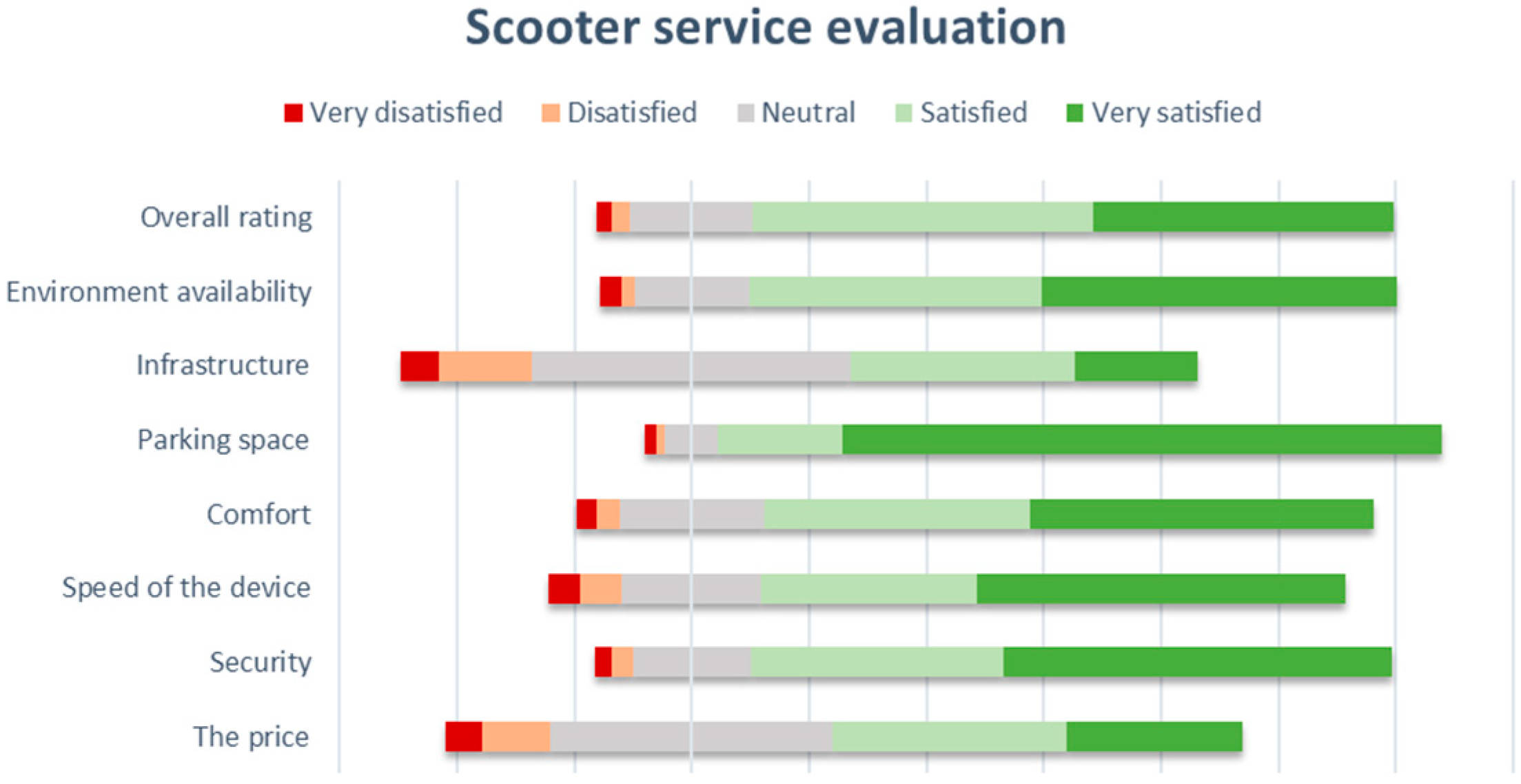
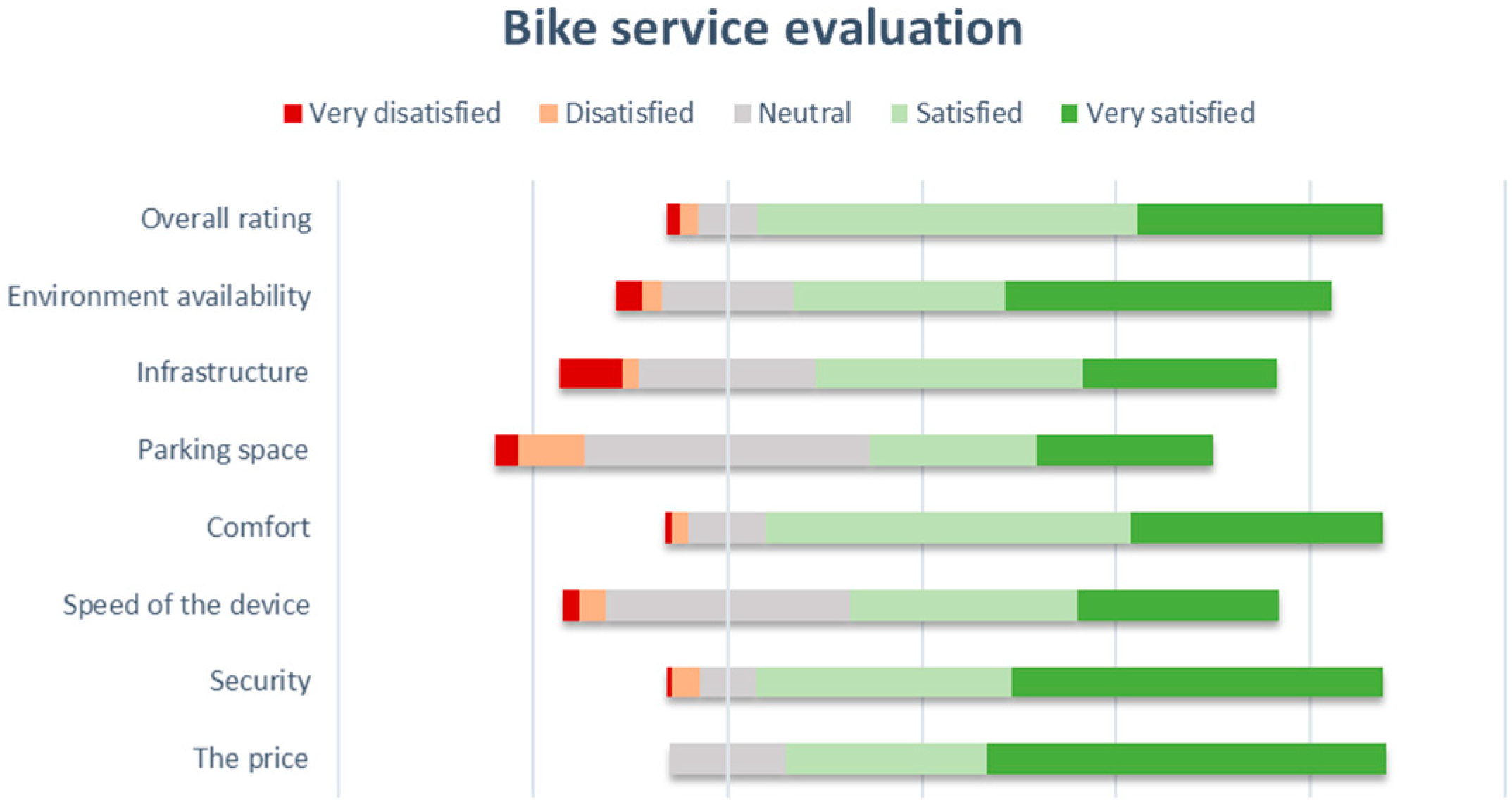
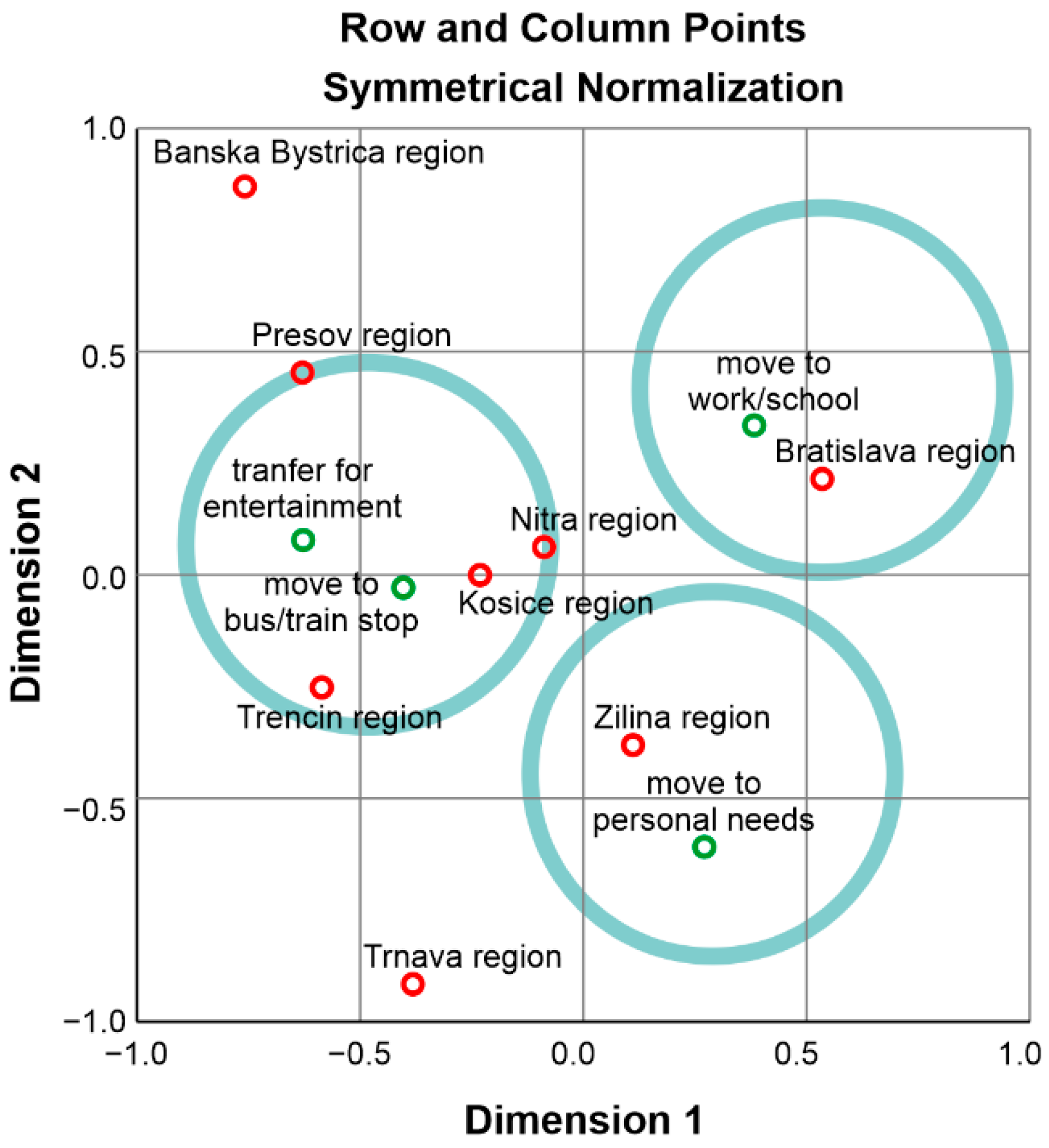

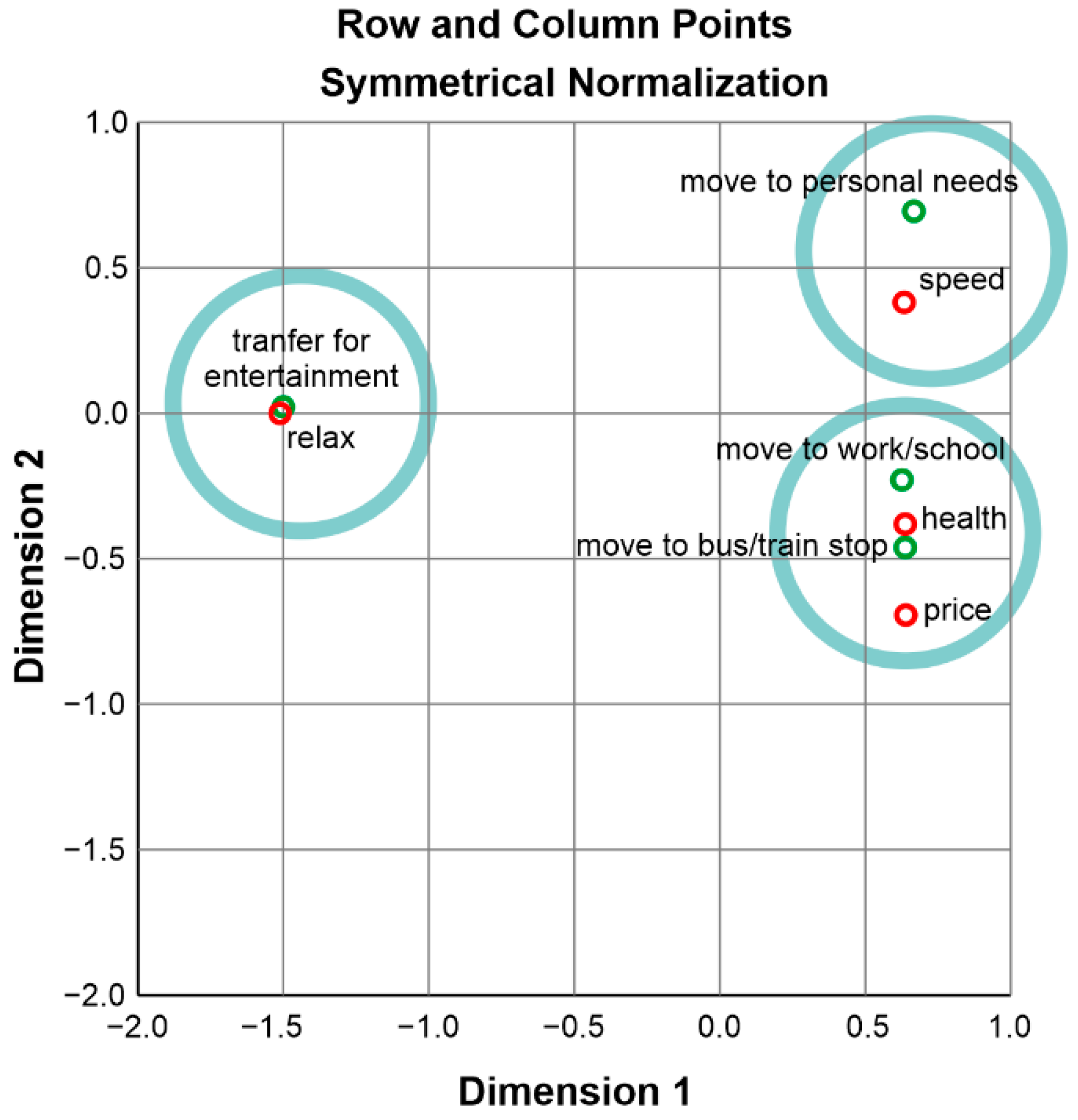
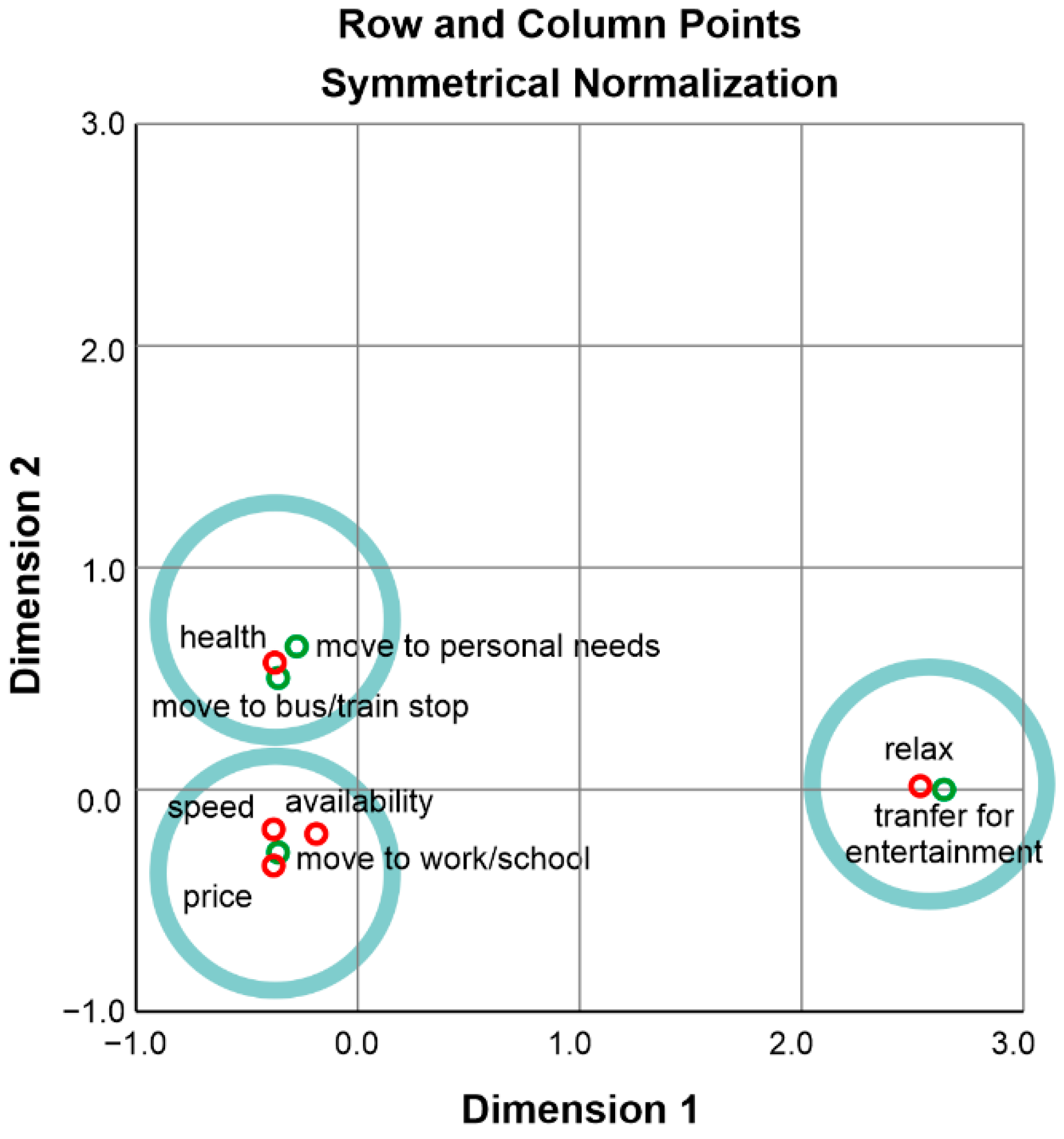
| Region | Gender | Total | |
|---|---|---|---|
| Male | Female | ||
| Western Slovakia | 431 | 62 | 493 |
| Central Slovakia | 332 | 38 | 370 |
| Eastern Slovakia | 161 | 24 | 185 |
| Total | 924 | 124 | 1048 |
| Mode of Transport | Only Once | Occasionally | 1–3 Times a Week | 4–6 Times a Week | Every Day | ni | |||||
|---|---|---|---|---|---|---|---|---|---|---|---|
| Shared scooters | 99 | 82.93 | 284 | 282.48 | 100 | 114.68 | 171 | 173.64 | 25 | 25.27 | 679 |
| 3.11 | 0.01 | 1.88 | 0.04 | 0.00 | |||||||
| Shared bicycles | 29 | 45.07 | 152 | 153.52 | 77 | 62.32 | 97 | 94.36 | 14 | 13.73 | 369 |
| 5.73 | 0.01 | 3.46 | 0.07 | 0.01 | |||||||
| nj | 128 | 436 | 177 | 268 | 39 | 1048 | |||||
| Mode of Transport | Transfer to Employment (Work/School) | Transfer to the Stop | Transfer to Personal Needs | Transfer for Entertainment | Other | ni | |||||
|---|---|---|---|---|---|---|---|---|---|---|---|
| Shared scooters | 153 | 227.41 | 108 | 123.10 | 252 | 181.41 | 157 | 128.93 | 9 | 18.14 | 679 |
| 24.35 | 1.85 | 27.47 | 6.11 | 4.61 | |||||||
| Shared bicycles | 198 | 123.59 | 82 | 66.90 | 28 | 98.59 | 42 | 70.07 | 19 | 9.86 | 369 |
| 44.81 | 3.41 | 50.54 | 11.24 | 8.48 | |||||||
| nj | 351 | 190 | 280 | 199 | 28 | 1048 | |||||
| Mode of Transport | Entertainment | Health | Transport Speed | The Price | Availability | ni | |||||
|---|---|---|---|---|---|---|---|---|---|---|---|
| Shared scooters | 157 | 130.88 | 69 | 114.03 | 226 | 198.26 | 80 | 128.93 | 147 | 106.90 | 679 |
| 5.21 | 17.78 | 3.88 | 18.57 | 15.04 | |||||||
| Shared bicycles | 45 | 71.12 | 107 | 61.97 | 80 | 107.74 | 119 | 70.07 | 18 | 58.10 | 369 |
| 9.60 | 32.72 | 7.14 | 34.17 | 27.67 | |||||||
| nj | 202 | 176 | 306 | 199 | 165 | 1048 | |||||
| No. | Hypothesis | p-Value | |
|---|---|---|---|
| Bike | Scooter | ||
| H1 | There is no significant association between the purpose for using the chosen alternative means of transport (shared bicycle or scooter) and the Slovak region. | >0.05 | 0.018 |
| H2 | There is no significant association between the reason for choosing the chosen alternative means of transport (shared bicycle or scooter) and the Slovak region. | >0.05 | 0.000 |
| H3 | There is no significant association between the purpose of using and the reason for the selected alternative transport mode (shared bicycle or scooter). | 0.000 | 0.000 |
| Purpose | Reason for Riding by Shared Scooter | Total | ||||
|---|---|---|---|---|---|---|
| Relax | Health | Speed | Price | Availability | ||
| Transfer for entertainment | 150 | 2 | 4 | 1 | 1 | 158 |
| Move to bus/train stop | 1 | 12 | 41 | 23 | 32 | 110 |
| Move to personal needs | 0 | 16 | 84 | 17 | 39 | 156 |
| Move to work/school | 6 | 19 | 97 | 39 | 74 | 255 |
| Total | 157 | 69 | 226 | 80 | 147 | 679 |
| Purpose | Reason for Riding by Shared Scooter | Total | ||||
|---|---|---|---|---|---|---|
| Relax | Health | Speed | Price | Availability | ||
| Transfer for entertainment | 41 | 0 | 0 | 0 | 1 | 42 |
| Move to bus/train stop | 1 | 33 | 21 | 32 | 3 | 90 |
| Move to personal needs | 1 | 12 | 4 | 9 | 2 | 28 |
| Move to work/school | 2 | 62 | 55 | 78 | 12 | 209 |
| Total | 45 | 107 | 80 | 119 | 18 | 369 |
Publisher’s Note: MDPI stays neutral with regard to jurisdictional claims in published maps and institutional affiliations. |
© 2022 by the authors. Licensee MDPI, Basel, Switzerland. This article is an open access article distributed under the terms and conditions of the Creative Commons Attribution (CC BY) license (https://creativecommons.org/licenses/by/4.0/).
Share and Cite
Štefancová, V.; Kalašová, A.; Čulík, K.; Mazanec, J.; Vojtek, M.; Mašek, J. Research on the Impact of COVID-19 on Micromobility Using Statistical Methods. Appl. Sci. 2022, 12, 8128. https://doi.org/10.3390/app12168128
Štefancová V, Kalašová A, Čulík K, Mazanec J, Vojtek M, Mašek J. Research on the Impact of COVID-19 on Micromobility Using Statistical Methods. Applied Sciences. 2022; 12(16):8128. https://doi.org/10.3390/app12168128
Chicago/Turabian StyleŠtefancová, Vladimíra, Alica Kalašová, Kristián Čulík, Jaroslav Mazanec, Martin Vojtek, and Jaroslav Mašek. 2022. "Research on the Impact of COVID-19 on Micromobility Using Statistical Methods" Applied Sciences 12, no. 16: 8128. https://doi.org/10.3390/app12168128
APA StyleŠtefancová, V., Kalašová, A., Čulík, K., Mazanec, J., Vojtek, M., & Mašek, J. (2022). Research on the Impact of COVID-19 on Micromobility Using Statistical Methods. Applied Sciences, 12(16), 8128. https://doi.org/10.3390/app12168128









